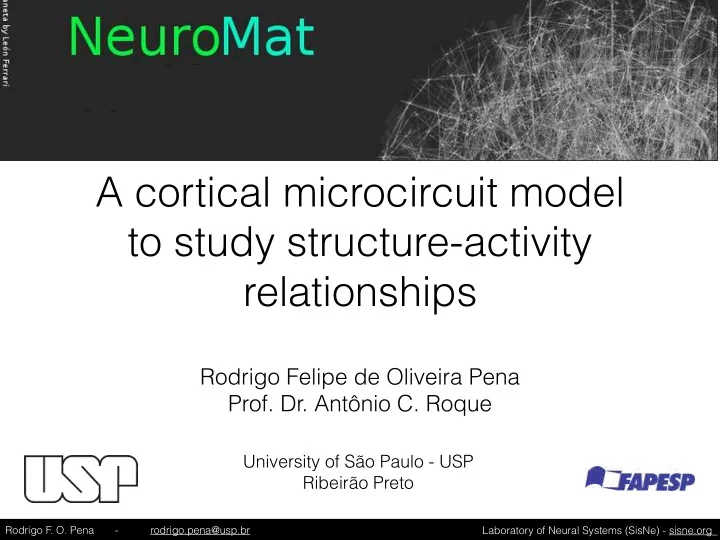

A cortical microcircuit model to study structure-activity relationships Rodrigo Felipe de Oliveira Pena Prof. Dr. Antônio C. Roque University of São Paulo - USP Ribeirão Preto Rodrigo F. O. Pena - rodrigo.pena@usp.br Laboratory of Neural Systems (SisNe) - sisne.org_
Neuronal variability Cortical connectivity Vertical view Morphology : pyramidal, basket, chandelier, etc 6 layers (I - VI) Specific electrophysiological patterns (a) RS (b) IB (c) CH (d) FS (e) LTS 1st NeuroMat young researchers workshop III ComplexNet Laboratory of Neural Systems (SisNe) - sisne.org_
Cortical signatures during self-sustained activity (SSA) • Slow (< 1 Hz) and high amplitude SSA network oscillations ; Subject is awake but not • Neurons with low firing rates submitted to sensory of • Non-Gaussian firing rate distribution behavioural tasks Hromádka et al., PLoS Biology 6:e16, 2008 1st NeuroMat young researchers workshop Laboratory of Neural Systems (SisNe) - sisne.org_
• Irregularity Maimon and Assad, Neuron 62:426-440, 2009 Haider et al., Nature 493:97-102, 2013 1st NeuroMat young researchers workshop Laboratory of Neural Systems (SisNe) - sisne.org_
What has been done recently? Motivation Despite growing data sets Classification of neuronal Relation between spiking patterns Cortical activity Improved knowledge of Electrophysiological classes cortical structure Cortical structure is poorly understood Different hypotheses to explain cortical dynamics It is important to have a model that reproduces all of the structured- activity of the cortex 1st NeuroMat young researchers workshop III ComplexNet Laboratory of Neural Systems (SisNe) - sisne.org_
Methods Neurons Izhikevich model Izhikevich, E. M. (2003). Spike Pre Synapses EPSP Post Exc: g max = g ex Inh: g max = g in 1st NeuroMat young researchers workshop III ComplexNet Laboratory of Neural Systems (SisNe) - sisne.org_
Methods Model Integrated connectivity map (Potjans and Diesmann, 2014) Full-scale 1mm ² microcircuit connectivity with 80.000 neurons 4000 Neurons Excitatory 768043 Synapses Neurons Excitatory Synapses L2/3 Inhibitory Neurons Background L4 Inhibitory input - rate 8Hz Synapses L5 L6 Thalamic Probability input - rate 15Hz Only connections with probabilities >0.04 are shown 1st NeuroMat young researchers workshop III ComplexNet Laboratory of Neural Systems (SisNe) - sisne.org_
Methods Building the model Spatial location 4000 Neurons - 80% excitatory and 20% inhibitory Cell’s spatial location is determined by it’s layer Divide them proportionally into Assume maximum delay is set to 10ms layers Connect following wiring rule 1st NeuroMat young researchers workshop III ComplexNet Laboratory of Neural Systems (SisNe) - sisne.org_
Methods Stimuli Scenario A Scenario B in vivo deafferentation cortico-cortical connections turn off thalamic input background input v =8Hz (poisson fixed rate) only background input v =8Hz thalamic connections thalamic input v =15Hz (poisson fixed rate) (L4 and L6) 1st NeuroMat young researchers workshop III ComplexNet Laboratory of Neural Systems (SisNe) - sisne.org_
Methods Measurements 1. Spike trains, membrane voltages 2. Individual and Mean population frequencies 3. ISI (interspike interval) - Time interval between spikes. 4. CV (coefficient of variation of a neuron’s ISIs) - Ratio of standard deviation to the mean. (Gabbiani and Koch, 1998; Dayan and Abbott, 2001; Laing and Lord, 2009) 5. Synchrony - Normalized to be between 0 and 1. (Golomb et. al., 2001) 1st NeuroMat young researchers workshop III ComplexNet Laboratory of Neural Systems (SisNe) - sisne.org_
Results Scenario A Experiment: Parameter search • We look for (cortical signatures): Collective low spiking frequency (< 1 Hz) Irregularity in the individual neuronal spikes Asynchronous activity Large sub-threshold fluctuations Simulation Parameters T simulation = 1000 ms 30 different seeds 1st NeuroMat young researchers workshop III ComplexNet Laboratory of Neural Systems (SisNe) - sisne.org_
Scenario A Results Experiment: Parameter search 1st NeuroMat young researchers workshop III ComplexNet Laboratory of Neural Systems (SisNe) - sisne.org_
Scenario A Results Experiment: Parameter search 1st NeuroMat young researchers workshop III ComplexNet Laboratory of Neural Systems (SisNe) - sisne.org_
Results (g ex = 4,g in = 15) 1st NeuroMat young researchers workshop III ComplexNet III ComplexNet Laboratory of Neural Systems (SisNe) - sisne.org_
(g ex = 4,g in = 15) Thalamic input is turned off at 500 ms Results Scenario A X Scenario B Similar to ‘UP' and ‘DOWN' states (two preferable subthreshold states during anesthesia) Steriade et al., (1993); Sanchez-Vives et al., (2000) 1st NeuroMat young researchers workshop III ComplexNet Laboratory of Neural Systems (SisNe) - sisne.org_
Summary and Conclusions Model of local cortical network shows realistic behavior Agreement with experimental recordings The model is being used to study structure-activity relationships NeuroMat members may use the model as a toy model 1st NeuroMat young researchers workshop III ComplexNet Laboratory of Neural Systems (SisNe) - sisne.org_
References Izhikevich, E. M., & Edelman, G. M. (2008). Binzegger, T., Douglas, R. J., & Martin, K. A. (2004). Laing and Lord, 2009 Brette et al., (2007). Mountcastle, V. B. (1997). Brunel N., (2000). Potjans, T. C., & Diesmann, M. (2014). (Dayan and Abbott, 2001) Sanchez-Vives et al., (2000) Douglas and Martin, (2004). Steriade et al., (1993); Gabbiani and Koch, 1998; Wester and Contreras (2012). (Golomb et. al., 2001) Izhikevich, E. M. (2003). Acknowledgements FAPESP/CEPID/Neuromat (grant 2013/07699-0). FAPESP 2013/25667-8. Using resources of the LCCA-Laboratory of Advanced Scientific Computation of the University of São Paulo. 1st NeuroMat young researchers workshop III ComplexNet Laboratory of Neural Systems (SisNe) - sisne.org_
Thank you very much! Rodrigo F. O. Pena - rodrigo.pena@usp.br Rodrigo F. O. Pena - rodrigo.pena@usp.br Laboratory of Neural Systems (SisNe) - sisne.org_
Recommend
More recommend